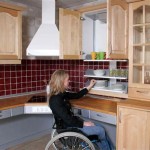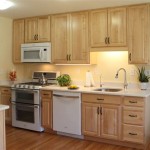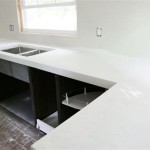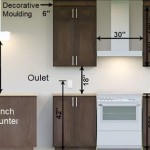Can You Paint Your Kitchen Cabinets The Same Color As Walls?
The question of whether to paint kitchen cabinets and walls the same color is a common one in interior design. The answer isn’t a simple yes or no. The decision hinges on several factors related to the desired aesthetic, the existing elements of the kitchen, and the practicalities of maintaining the space. This article explores the considerations involved in opting for a monochromatic kitchen, weighing the potential benefits and drawbacks of such a design choice.
A monochromatic kitchen, where cabinets and walls share the same hue, presents a specific set of design opportunities. It can create a sense of visual unity and spaciousness, especially in smaller kitchens. The consistent color palette eliminates visual breaks, allowing the eye to travel smoothly around the room, which can make it feel larger and more open. This approach is particularly well-suited to minimalist or modern designs, where simplicity and clean lines are paramount.
However, a monochromatic scheme also poses challenges. Without careful planning, the kitchen can appear flat, boring, and lacking in dimension. To avoid this, it's crucial to consider variations in texture, sheen, and accent colors. Introducing different textures, such as a textured backsplash or natural wood elements, can add visual interest and prevent the space from feeling monotonous. The chosen color itself also plays a significant role. Light, neutral colors are more forgiving than bold, saturated shades, which can quickly become overwhelming when used extensively.
The existing style of the kitchen is a primary factor in determining the suitability of a monochromatic paint scheme. In contemporary kitchens with sleek, handleless cabinets and minimalist countertops, a unified color palette can enhance the clean, modern aesthetic. Conversely, in traditional kitchens with ornate cabinetry and detailed moldings, a single color might obscure the architectural details and diminish the character of the space. In such cases, a contrasting color for the cabinets or strategic use of highlighting techniques can be more effective.
Furthermore, the materials used throughout the kitchen should be considered. If the countertops are a distinct color or pattern, painting the cabinets and walls the same color can create a cohesive backdrop that allows the countertops to stand out as a focal point. Similarly, if the flooring has a strong pattern or color, a monochromatic wall and cabinet color can help to balance the overall design and prevent the kitchen from feeling too busy.
Practical considerations also need to be addressed. Kitchen cabinets are subjected to a lot of wear and tear, and a single color across both cabinets and walls means that any discrepancies in wear will be more noticeable. Choosing durable, easy-to-clean paint finishes is therefore essential. The type of paint used for cabinets versus walls might also differ. Cabinet paint typically requires a harder, more durable finish to withstand frequent use and cleaning. It is also essential to consider the lighting in the kitchen. Natural light can affect how a color appears, and artificial lighting can create shadows that emphasize or diminish the monochromatic effect. It is therefore vital to test the chosen color in different lighting conditions before committing to the entire project.
Key Point 1: Creating Visual Interest Through Texture and Sheen
When opting for a monochromatic kitchen, the risk of creating a flat, uninteresting space is significant. To mitigate this, incorporating different textures is crucial. This can be achieved through various means, such as a textured backsplash made of tile, stone, or even textured wallpaper. Using different materials for countertops, such as butcher block or granite, can also introduce textural variation. The addition of natural elements like wooden shelves or cutting boards can further enhance the textural richness of the kitchen. Another vital tool is varying the paint sheen. Using a matte finish on the walls and a semi-gloss or gloss finish on the cabinets will create a subtle contrast that adds depth and visual interest to the space. This difference in sheen allows the cabinets to reflect light differently from the walls, making them stand out without introducing a different color. The overall effect is a more dynamic and engaging space, even within a limited color range.
Rugs and textiles also play a significant role in adding texture to a monochromatic kitchen. A sisal rug, for instance, can introduce a natural, earthy texture that contrasts well with painted surfaces. Similarly, linen or textured cotton curtains can soften the hard lines of the cabinets and walls. These elements not only add visual interest but also contribute to the overall comfort and warmth of the kitchen.
Another effective technique is to incorporate architectural details that add texture and dimension. This could involve adding crown molding to the cabinets or installing decorative trim on the walls. These details create shadows and highlights that break up the monotony of a single color and add a sense of depth to the space. The selection of hardware for the cabinets is another area where texture can be introduced. Choosing knobs and pulls in different materials, such as brushed nickel, antique bronze, or even leather, can add a tactile element to the design.
Key Point 2: The Importance of Lighting and Color Selection
The lighting within a kitchen and the specific shade chosen are critical factors in determining the success of a monochromatic paint scheme. Natural light, in particular, can dramatically affect how a color appears. A color that looks beautiful in direct sunlight might appear dull and lifeless in a room with limited natural light. Therefore, it's essential to test the chosen color in different lighting conditions throughout the day before committing to the entire project. Artificial lighting also plays a crucial role. Warm-toned lighting can make a color appear warmer and more inviting, while cool-toned lighting can create a more modern and sterile feel. It is important to select light bulbs that complement the chosen color and create the desired ambiance.
The specific shade of color selected is equally important. Light, neutral colors, such as white, off-white, or light gray, are generally more forgiving and easier to work with in a monochromatic scheme. These colors reflect light well and can help to make a small kitchen feel larger and more open. Darker colors, such as navy blue, deep green, or charcoal gray, can create a more dramatic and sophisticated look, but they also require careful consideration. Dark colors can absorb light and make a space feel smaller and more enclosed. They are best suited for kitchens with ample natural light and high ceilings.
It's also important to consider the undertones of the chosen color. Many colors have subtle undertones that can affect how they appear in different lighting conditions. For example, a white paint with warm undertones might appear creamy or yellow in certain lights, while a white paint with cool undertones might appear gray or blue. It's therefore essential to test the color against other elements in the kitchen, such as countertops, flooring, and appliances, to ensure that it complements the existing design.
Key Point 3: Paint Finish and Durability Considerations
The durability and finish of the paint are particularly important in a kitchen, where surfaces are subjected to frequent use and cleaning. Cabinets, in particular, require a durable finish that can withstand scratches, stains, and moisture. A semi-gloss or gloss finish is generally recommended for kitchen cabinets, as these finishes are easier to clean and more resistant to damage. However, a high-gloss finish can also highlight imperfections in the cabinets, so it's important to prepare the surfaces properly before painting. A satin or eggshell finish is often preferred for walls, as these finishes are less reflective and can help to conceal imperfections. However, they are also more difficult to clean than semi-gloss or gloss finishes. Therefore, it's important to consider the specific needs of the kitchen when choosing a paint finish.
The type of paint used is also crucial. Latex paint is generally recommended for kitchen cabinets and walls, as it is durable, easy to clean, and low in VOCs (volatile organic compounds). However, oil-based paints are also an option, as they provide a harder, more durable finish. Oil-based paints are more difficult to work with and require more time to dry, but they are also more resistant to stains and scratches. It's important to choose a high-quality paint that is specifically formulated for use on cabinets and walls. This will ensure that the paint adheres properly, provides adequate coverage, and lasts for many years.
Proper preparation is essential for achieving a durable and long-lasting paint job. This includes cleaning the surfaces thoroughly, sanding them to create a smooth surface, and priming them to ensure that the paint adheres properly. It's also important to use high-quality brushes and rollers to apply the paint evenly and avoid drips and streaks. Taking the time to prepare the surfaces properly will result in a more professional-looking finish and a paint job that lasts for many years.
In summary, painting kitchen cabinets and walls the same color involves a nuanced approach that weighs visual appeal, practical maintenance, and existing kitchen features. While a monochromatic scheme presents opportunities for creating spaciousness and visual unity, it demands careful attention to texture, sheen variations, strategic lighting, and durable paint selection. Successfully implementing this design choice requires a thorough understanding of these considerations and a willingness to adapt the approach to suit the unique characteristics of each kitchen.

Can You Paint Your Cabinets The Same Colour As Walls

Choosing The Perfect Kitchen Cabinet Color To Match Your Walls Plank And Pillow

Can You Paint Your Cabinets The Same Colour As Walls

Should Your Kitchen Cabinets And Walls Be The Same Color

How To Choose The Right Paint Color For Your Kitchen Paintzen

This Paint Trick Will Make Your Room Look Bigger Than It Actually Is Kitchen Wall Cabinets Dark Blue Kitchens Renovation

Can You Paint Kitchen Cabinets Two Colors In A Small The Decorologist

The 16 Best Wall Colors To Update Cream Cabinets Trim Kylie M Interiors

11 Wall Paint Colors To Pair With White Kitchen Cabinets Domino

What To Do When You Secretly Love Cream Kitchen Cabinets Heather Hungeling Design
Related Posts








